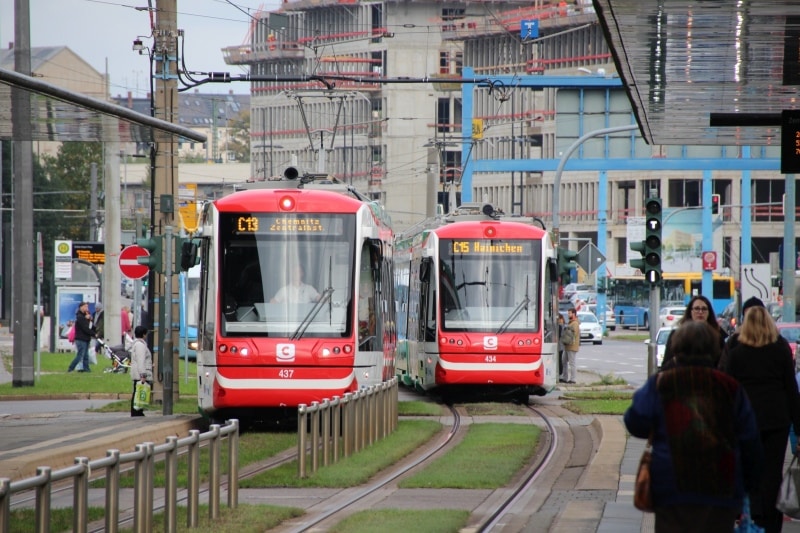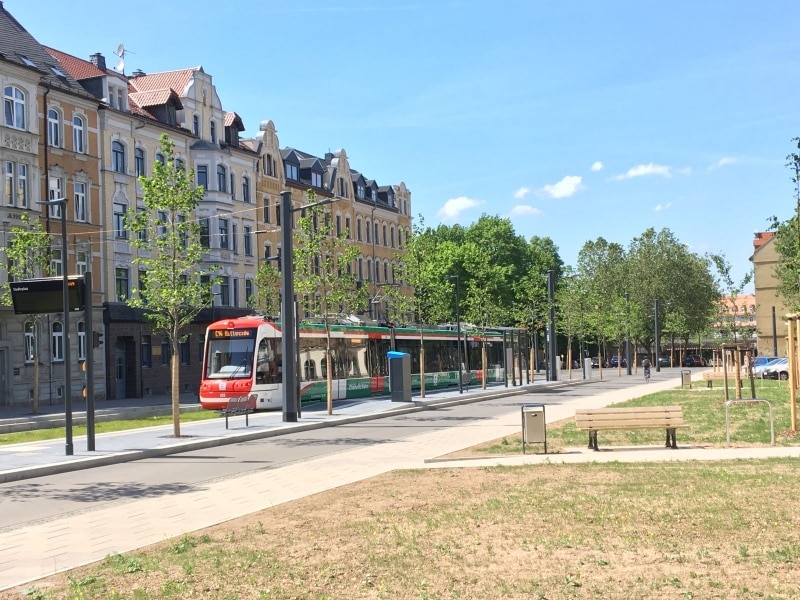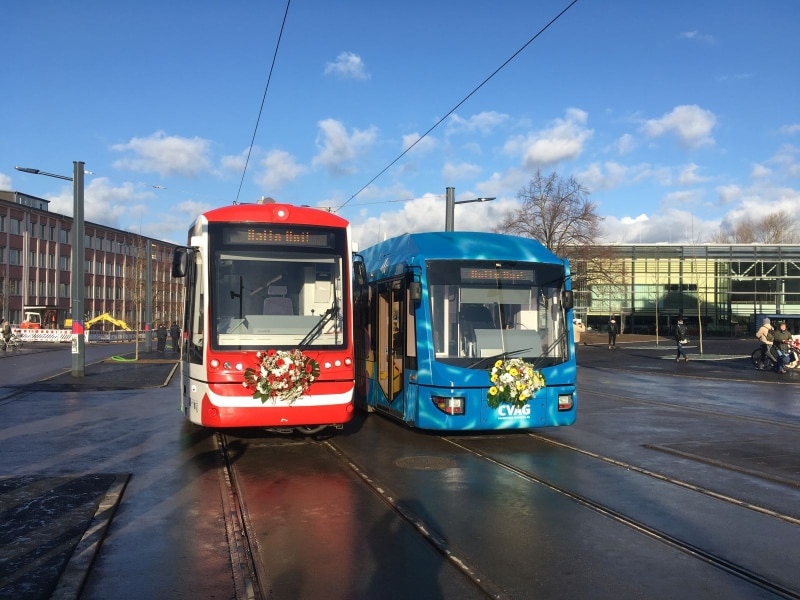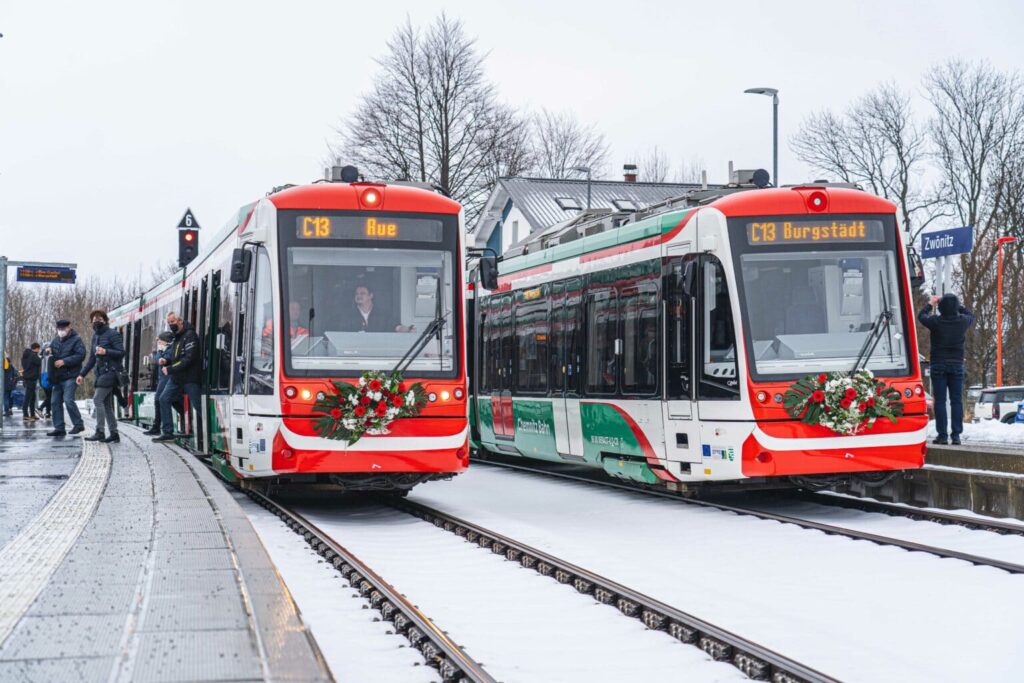The Chemnitz Model
Contents and goals
Connecting the city and the region without changing trains - that is the common vision of all those involved in the "Chemnitz Model": Passengers board a modern, comfortable city-surrounding train in Burgstädt or Mittweida, in Stollberg or Thalheim, which takes them directly to the city centre of Chemnitz.
Together with the existing local transport services, these new connections are linked to form a complex system. Buses take passengers from smaller stops to the stops of the Stadt-Umland-Bahn, which they reach without wasting time and without long distances thanks to an optimal frequency.
City and region are thus growing closer together. The regional centre of Chemnitz and its charming surroundings will become a living space that combines the different qualities of life in the city and the countryside through improved transport connections. The historically grown roots of the city of Chemnitz with its region will thus be revived.
Living in the region and commuting easily to the city for work and shopping - or living in the city and easily reaching the region's leisure and recreational opportunities - these are advantages of living in Central Saxony that will come to fruition in a unique way through the Chemnitz Model.
The first ideas of linking tramway and railway in 1992, based on the already existing Karlsruhe model, were positively supported in 1995 in a feasibility study commissioned by the Saxon Ministry of Economics and Labour (SMWA) and reached their first climax with the commissioning of the pilot line Chemnitz - Stollberg on 15 December 2002.
The Chemnitz - Stollberg pilot line
In order to demonstrate the regional development prospects of a transfer-free connection between the city and the region and thus give the whole vision momentum, those responsible for the Chemnitz Model decided to first implement a pilot route. This was to prove the feasibility and practicality of the system-connecting approach.
The choice fell on the Chemnitz Hbf - Chemnitz Zentralhaltestelle - Altchemnitz - Stollberg route.
The route is 23 kilometres long and consists of three sections:
- Tram line from Chemnitz Hbf to Altchemnitz
- Linking point in Altchemnitz
- Railway line from Altchemnitz to Stollberg
The tracks of the first part start at the main station, open up the city centre with its cultural institutions, the Technical University, municipal and regional offices and shopping facilities. At the central stop, the track is linked to all bus and tram lines of the city and regional transport system via short and convenient interchanges. Towards the south, the route connects with Annaberger Straße as far as Altchemnitz.
There, the Variobahns travel via the connection point from the double-track tram network to the single-track railway network. A switch was necessary to establish the track connection between tram and railway. Two worlds come together here: on the one hand, the tram with light railcars, narrow track radii in streets, running on sight and stopping at normal traffic lights; on the other hand, the railway with heavy trains, large track radii, independence from other traffic and running according to signals.
The newly erected overhead line above the railway section is also connected to the tramway overhead line. The new one has a voltage level of 750 V DC, the power grid of CVAG is fed with 600 V DC.
In Altchemnitz, a comfortable and functional transport hub was also created with interchanges to all lines operating here with platforms for a door-to-door solution from bus to train.
The third section of the pilot line is the Altchemnitz - Stollberg railway line. This section is single-track and trains can only meet at the crossing stations in Neukirchen-Klaffenbach and in Pfaffenhain (new construction). In the single-track sections and the stations, modern safety technology (ESTW - interlocking) with automatic track vacancy detection and point-based train control is used.
The higher line speed and the dense train sequence compared to the past required the modernisation, expansion and new installation of technically secured level crossings.
Train dispatchers monitor and control the entire line with all technical equipment from the electronic signal box in Stollberg.
Special solutions in the superstructure, such as the installation of movable frog points and raised check rails in points and rail grooves heated in frosty conditions in level crossings, serve to ensure safe operation. Six rectifier substations along the route feed the catenary.
Four new stations were added: in the city of Chemnitz, the Riemenschneiderstraße and Klaffenbach stops, in Stollberg the Schlachthofstraße stop, and later in 2006 the Chemnitz Friedrichstraße stop. All stations were built according to modern criteria. These include a platform height of 20 cm for level boarding and alighting, passenger shelters with information facilities, dynamic passenger information, parking facilities for bicycles and cars and improved transfer connections to the regional bus lines.
The Stollberg - Lichtenstein - Glauchau line also starts and ends at Stollberg station. Therefore, the station has several platforms. The transfer to the bus lines is ensured by the bus station in the immediate vicinity of the end point of the pilot line.
Chemnitz main station interchange
In the past, most regional railway lines ended at Chemnitz main station. For historical reasons, this is located in Chemnitz somewhat outside the city centre. With the pilot line Chemnitz - Stollberg, the Chemnitz street centre was also served for the first time.
With the next expansion stage of the Chemnitz model, passengers can reach the pulsating heart of Chemnitz directly, also from the north. For this purpose, the DB Netz AG ice rink infrastructure at the main station was connected to the CVAG network and the regional trains were routed via this link to Chemnitz city centre. In this way, the advantages of an improved connection between the city and the region come to full fruition.
Conventional trams and the new city-surrounding trains stop directly in the station concourse and reach either the tram network or the railway network from there. This not only improves the connection between the city and the surrounding area, but also creates better transition possibilities between the lines of the Chemnitz model, regional transport, urban local transport and perhaps also DB long-distance transport again. This is because the platforms are located directly next to those of the DB.
"Vehicles of the future" used to be... now they are here!
The chosen use of Variobahns with direct current drive and the necessary electrification of the lines is not possible on all lines planned for the Chemnitz model. On some of the planned lines, joint operation with mainline vehicles is on the agenda. This results in extended restrictions. The platforms will be 38 cm or higher, the catenary, if present, will have 15 kV 16 2/3 Hz AC and the vehicles will have to meet more severe crash scenarios.
The dual-system vehicles for the Chemnitz model were ordered by the Mittelsachsen Transport Association (VMS) on 14 August 2012. The first vehicles were delivered in 2015.
The contract was awarded to the consortium formed for this tender by the companies Vossloh Kiepe GmbH and Vossloh España S.A. (in short: Vossloh). Vossloh submitted the most economical bid that meets the requirements of the ZVMS.
The order value for the initial eight vehicles amounts to 42.3 million euros. There is an option for two more vehicles. The financing of the vehicles is only possible with the support of the Free State of Saxony.
The Saxon State Ministry of Economic Affairs, Labour and Transport (SMWA) has placed the vehicle procurement for the Chemnitz Model in the ERDF programme (European Regional Development Fund). The urban public transport system was included in the Operational Programme for ERDF funding. Funding from the Free State is thus secured. In total, more than 31 million euros in funding will be made available from the ERDF programme, with the ZVMS contributing a share of almost 11 million euros.
The vehicles ordered belong to Vossloh's "Citylink family" and have been specially adapted to the requirements for use in the Chemnitz model. The vehicles are designed for a maximum speed of 100 km/h. The 37-metre-long air-conditioned bi-directional vehicles have 94 seats. Due to the air suspension, there is a particularly high level of travel comfort for the passengers. The details of the vehicles' equipment were clarified in the specifications phase.
Commissioning of stage 1 of the Chemnitz Model
On 10 October 2016, the ceremonial commissioning of Stage 1 of the Chemnitz Model took place. There is now a transfer-free transport service from the towns of Burgstädt, Mittweida and Hainichen via Chemnitz main station to the central stop every 1 hour. Line C13 runs between Burgstädt and Chemnitz, line C14 takes passengers from Mittweida to Chemnitz and back. Line C15 connects Chemnitz city centre with Hainichen.


Opening of Stadlerplatz stop
In May 2017, the new stop "Stadlerplatz" was ceremoniously put into operation. The Chemnitz Model lines C13 and C14 to and from Burgstädt and Mittweida now run every hour from the central stop via Reitbahnstraße, Bernsdorferstraße and Turnstraße to Reichenhainer Straße, at Lutherstraße. The first departure from the new stop in regular service was at 11:51 a.m. with line C13 in the direction of Burgstädt.
From June 2017, the C15 line from and to Hainichen was also integrated here.
Opening of the Technopark stop at the TU Chemnitz
On 8 December 2017, the new tram route along Reichenhainer Straße to Technopark was opened. The Citylink trams of lines C13, C14 and C15 to and from Burgstädt. Mittweida and Hainichen are thus linked through to the Chemnitz University of Technology. Another section of the Chemnitz Model - Stage 2 was thus opened.


Chemnitz - Aue railway line
On 29 January 2022, the first Citylinks rolled on the upgraded, 47-kilometre-long railway line. Line C13 (Burgstädt Chemnitz) was extended to Aue and line C14 (Mittweida Chemnitz) to Thalheim. This creates an attractive 30-minute frequency on the Chemnitz Thalheim section. The Thalheim Aue section is served every hour.
Further planned network development
Chemnitz - Niederwiesa
Construction of a tram line between Chemnitz main station and Chemnitz-Hilbersdorf to provide access to the Sachsen-Allee shopping centre and the residential areas of Hilbersdorf and Ebersdorf, continuing via the former freight track to Niederwiesa
Chemnitz - Limbach-Oberfrohna
Construction of a tram line from Chemnitz city centre via Leipziger Straße to Chemnitz-Center and continuation on the railway line to Limbach-Oberfrohna
Stollberg - Oelsnitz
Extension of the Chemnitz - Stollberg pilot line via the Stollberger Tor industrial estate and integration into the Stollberg - St.Egidien line at Niederwürschnitz. This will allow continuous trains to run from Chemnitz to Oelsnitz without changing direction.